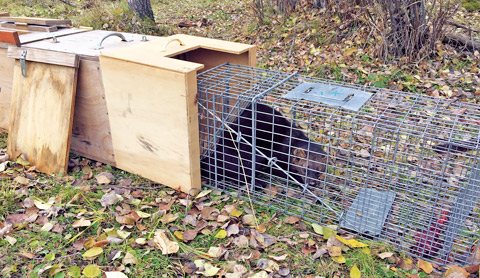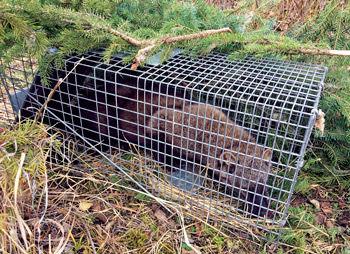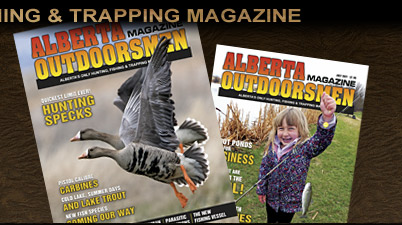|
 |
For me, one of most interesting members of the weasel family is the fisher. While most folks probably don’t know what a fisher is, as they are seldom discussed outside of the trapping community and seldom seen near populated areas, they are one of the largest members of the weasel family with males growing to, on average, 8 to 12 pounds, although trappers will tell you they can grow much larger, even up to 18 pounds. The fisher is also an agile climber; however, it spends most of its time on the forest floor. The fisher is very fast, a meat eater, and one of the few predators that can efficiently hunt down and kill a porcupine. The porcupine and snowshoe hare are considered their primary prey.
 |
| The author’s first fisher being tranferred from live cage trap to transport box. |
Alberta is home to a healthy population of fishers with nearly 1500 trapped on average each year throughout the boreal forest by Alberta trappers. While the females bring in a better price for their fur than the males do, fishers are still considered an important animal of the fur trade and have been trapped since the 18th Century. However, through unregulated trapping and habitat loss, fishers were eliminated from many parts of their historic range south of the border, including Washington State by the mid-1900s.
In 1998, the Washington Fish and Wildlife Commission listed the fisher as endangered in that state. From 2008 to 2010, Washington began a fisher relocation program and by using trappers from British Columbia, were able to live capture and release 90 fishers in Olympic National Park, where the species is now widely distributed and reproducing.
In 2015, Washington State decided to reintroduce fishers to the Cascade Range and again with the help of BC trappers, relocated 80 fishers from that province. However, wild fires in BC put an end to the program because too much fisher habitat had been lost. Enter Alberta trappers.
Starting this year, several Alberta trappers, myself included, have been enlisted to live capture 50 fishers, 30 females and 20 males.
 |
| The large male fisher in the live cage trap. |
Each trapper was given a training session, four live cage traps, and two transport boxes. Each trap set is checked by the trapper every day, twice if possible, and once a fisher is captured, it must be immediately transported to the project coordinator. From there, the fisher is taken to the Calgary Zoo where it undergoes a veterinary exam and is equipped with a radio-transmitter so its “movements and survival status can be tracked” once released. Because of stress placed upon the fisher once captured, all of the above needs to take place in a very timely fashion with the utmost care being taken to ensure the fisher is comfortable, watered, and fed. From the time of capture to its release, three weeks is considered the maximum timespan. A data form is filled out daily by the trapper for each live trap and once a fisher is captured, every movement made is recorded.
I’m happy to report that to date, I have managed to live capture two fishers, one small female and a very large male.
The importance of trappers should not be understated; trappers are an invaluable tool of wildlife managers everywhere, and I am proud to play a part in that. ■
For previous Outdoor Pursuits click here.
|
|
|
|


